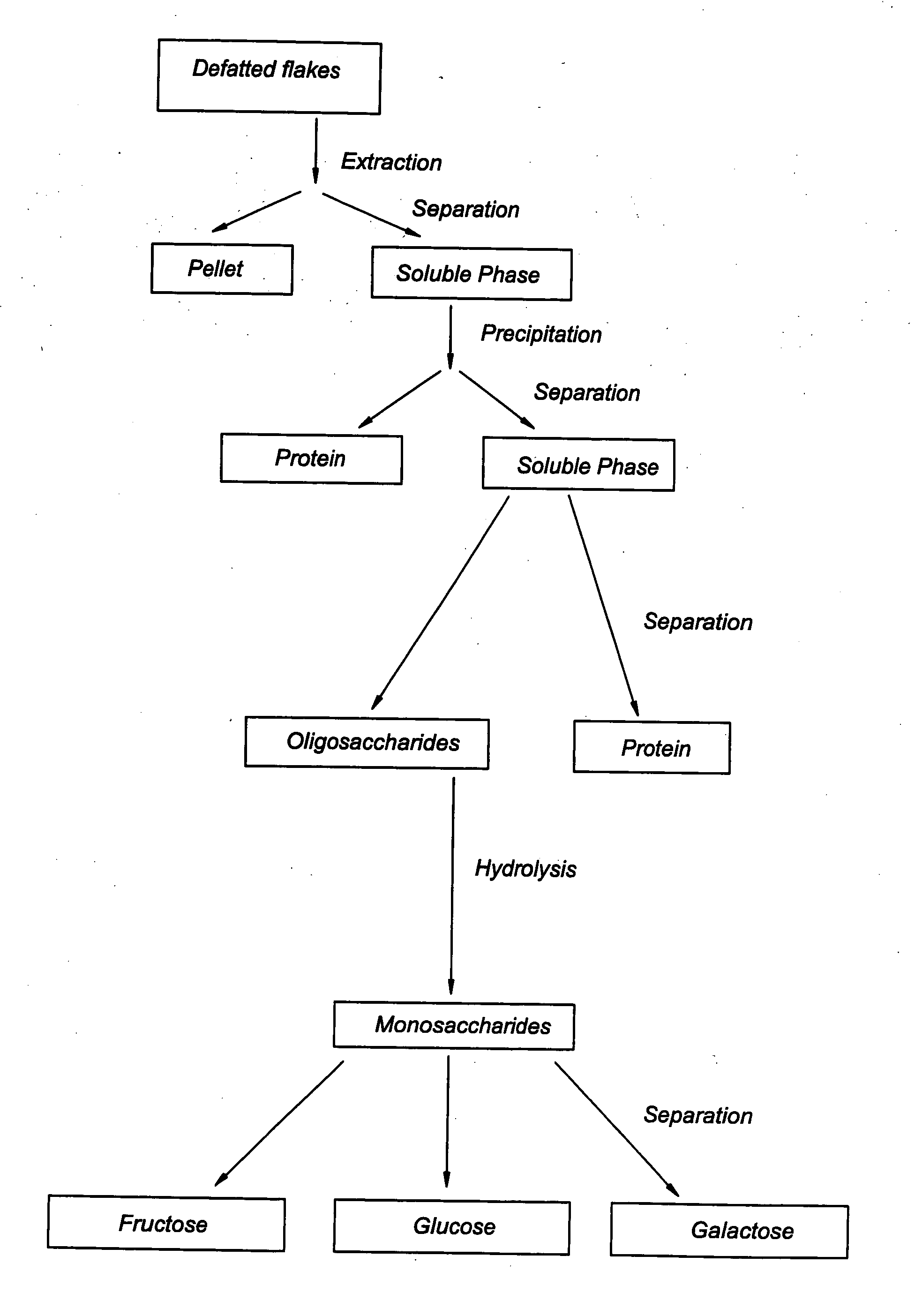D-galactose isolation system
a technology of d-galactose and isolation system, which is applied in the preparation of sugar derivatives, saccharides, sugar derivatives, etc., can solve the problems of limited and unlikely to increase milk supply, partially quantitative use of milk products as raw materials for the production of d-galactose, and insufficient supply
- Summary
- Abstract
- Description
- Claims
- Application Information
AI Technical Summary
Benefits of technology
Problems solved by technology
Method used
Image
Examples
example 1
[0053] On a pilot plant scale, 150 liters of water having a temperature of about 20.degree. C. was added to 30 kg defatted soybean flakes and stirred to form a uniform mixture. After 20 minutes, insoluble components in said mixture were separated from the soluble fraction by decanting. Hydrochloric acid was added to the soluble fraction to conduct acid precipitation at pH 4.5, followed by centrifugation at 7800.times.g to separate the insolubles from the solubles. The soluble fraction was further treated using ultrafiltration. The ultrafiltration membrane had a theoretical molecular weight cut-off of 5.000 Dalton. The retentate was separated from the permeate, which contained soluble saccharides. The permeate contained about 50% saccharides on dry weight basis.
[0054] 0.1% Alpha-gal 600 L (Novo-Nordisk) based on dry matter was added. (Alpha-gal 600 L is an enzyme preparation containing both alpha-galactosidic activity and beta-fructofuranosidic activity). The polysaccharides within t...
example 2
[0055] On a pilot plant scale, 150 liters of water having a temperature of about 20.degree. C. was added to 30 kg defatted soybean flakes and stirred to form a uniform mixture. After 20 minutes insoluble components in said mixture were separated from the soluble fraction by decanting. Hydrochloric acid was added to the soluble fraction to adjust pH to about 4.5. The formed precipitate was removed by centrifugation at 7800.times.g. The remaining soluble fraction thus obtained contained at least 30% oligosaccharides on a dry weight.
[0056] 0.1% Alpha-gal 600 L based on dry matter was added. The polysaccharides within the permeate soluble saccharides on dry weight basis were hydrolyzed to a preparation containing mainly monosaccharides, by incubating the mixture for 4 hours at 50.degree. C. The D-galactose content of the preparation thus obtained was about 5% on a dry weight basis.
example 3
[0057] According to the same manner as described in Example 2, the preparation containing about 5% D-galactose on dry weight basis was obtained.
[0058] The preparation was then further treated using ultrafiltration. The ultrafiltration membrane had a theoretical molecular weight cut-off of 5.000 Dalton. The retentate was separated from the permeate, which contained soluble saccharides. The permeate contained about 5-10% D-galactose on dry weight basis.
PUM
| Property | Measurement | Unit |
|---|---|---|
| Fraction | aaaaa | aaaaa |
| Fraction | aaaaa | aaaaa |
| Fraction | aaaaa | aaaaa |
Abstract
Description
Claims
Application Information
 Login to View More
Login to View More - R&D
- Intellectual Property
- Life Sciences
- Materials
- Tech Scout
- Unparalleled Data Quality
- Higher Quality Content
- 60% Fewer Hallucinations
Browse by: Latest US Patents, China's latest patents, Technical Efficacy Thesaurus, Application Domain, Technology Topic, Popular Technical Reports.
© 2025 PatSnap. All rights reserved.Legal|Privacy policy|Modern Slavery Act Transparency Statement|Sitemap|About US| Contact US: help@patsnap.com

